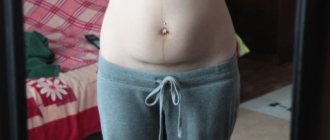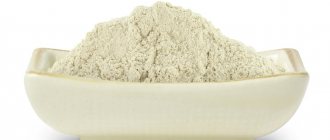Once your lip has healed, buy a natural, unscented beeswax lip balm and apply it to your lips regularly. It’s even better if the balm contains lanolin or petroleum jelly. Some lip balms even have an SPF level and can protect your lips from drying out from the sun's rays.
Drink more water.
To maintain normal fluid balance in your body and prevent chapped lips, drink at least eight glasses of water a day. To speed up the healing of a wound on your lip, add a couple more glasses to this amount.
Young children very often suffer various injuries. Babies are exploring the world, moving a lot, but they still do not know how to control their movements. They often fall and bump into furniture, door frames and other objects. Often in such cases the face suffers, and primarily the lips.
If a child has a broken lip, then you need to, first of all, try to calm him down. The baby should be given first aid, but do not panic or be very nervous.
First aid
A broken lip in a child is a rather scary sight, since such injuries usually bleed heavily. But do not think that the baby is at risk of severe blood loss. First aid in such cases consists of clear and correct actions:
- First, you should thoroughly wash your hands and your baby's hands. After all, the baby constantly touches the resulting wound. If it is not possible to wash your hands, you can treat them with any antiseptic.
The bruised area is carefully treated with hydrogen peroxide.
A child has a broken lip from the inside, it is swollen, what should I do?
Cases where a child breaks his lip from the inside are much more difficult to treat than external injuries. The reasons for this are constant contact with saliva, introduction of bacteria into the wound and frequent resumption of bleeding due to damage to the resulting blood clot. To prevent infection of the resulting wound, you need to treat the wound several times a day with antiseptic drugs such as chlorhexidine, miramistin, chamomile decoction and others. To do this, you can carefully apply the product to the wound using a cotton pad or rinse your mouth with it.
The child broke his upper lip
External injuries to the lips, as a rule, bleed heavily, which causes hysterics in the child and panic in the parents. So first you need to calm down. Then wash your hands or sanitize them thoroughly. The damaged area should be washed with clean boiled water and then treated with peroxide, applying it to a cotton swab and applying it to the wound. Instead of a cotton swab, you can use a clean handkerchief, a piece of clean cloth, cotton swabs and other means. Instead of peroxide, you can use a weak solution of potassium permanganate. It is important to determine the size of the wound. In case of severe injuries, you should seek medical help.
Manifestations
When the lip is injured, characteristic symptoms appear such as:
- pronounced swelling. The tissues in the lip area swell very quickly, literally before our eyes;
- formation of a seal inside the lips;
- pain, discomfort in the damaged area;
- bleeding if the integrity of the structures has been compromised and there is a wound surface;
- redness of the skin near the injury site.
The swelling may last for several days without changing in severity.
A child often has abrasions near the mouth along with swelling, which is the result of falling face down.
What to do for a severe laceration of the lip
If an accident occurs that results in a deep bruised wound to the lip, you should immediately contact a surgeon. Treatment of such a wound will most likely be surgical. For a faster and more effective rehabilitation process, as well as recovery, it would be better for the patient not to refuse surgery. A fairly good remedy for treating a lacerated wound of the lip from the inside can be rinsing or special lotions with chamomile infusion. To enhance regeneration and speed up the healing of lip tissue, the use of a special gel for teeth will be very useful. If the patient, in addition to the wound on the lip, has other injuries, it is necessary to call a doctor and be with the victim until he arrives. After the victim has been thoroughly examined and examined by a doctor, the patient is prescribed the most appropriate treatment.
There are many reasons why lip injuries occur: an accident at work, a fall. If a person receives a laceration, he should be given first aid. It is necessary to carry out treatment and washing with disinfectants. Then apply ice to the affected area to prevent swelling. If a lacerated wound of the lip appears, the use of lanolin, sea buckthorn or olive oil will be effective in its treatment. To soften the skin on the lips, at the site of injury, for quick healing, you need to smear the wound with an ointment based on zinc and propolis. Good remedies for healing a lacerated wound of the lip are Actovegin and Solcoseryl ointments.
To achieve rapid healing, you need to apply the ointment quite often. The process of treating such a wound must be approached very seriously and there should be no delay. If you do nothing and do not treat the injury, within a few days a purulent abscess may form on the wound, which can become a prerequisite for blood poisoning. But there is no need to treat the lacerated wound with brilliant green or iodine, because these medications can lead to burns on the rather delicate skin of the lips.
If the lip is broken on the inside, and a laceration has also formed, the first thing to do is treat it with a solution of Miramistin or chlorhexidine, and then immediately see a surgeon.
First aid methods
If a child or adult’s lip is swollen after a blow, what should you do? In this case, first aid is to:
- Gently rinse the damaged area;
- wipe the open wound with Miramistin or Chlorhexidine solution to prevent the possibility of infections. If there is a violation of the integrity of the tissues on the inside (in the oral cavity), these products can also be used for disinfection. An external lip injury can also be treated with hydrogen peroxide, but in no case should you use brilliant green or iodine - they can cause a burn;
- to prevent the formation of extensive edema. Do not leave the compress on for more than 15 minutes, otherwise tissue frostbite may occur.
If blood continues to flow from the wound, you need to fold a piece of bandage several times and place it between your lip and teeth so that it is absorbed.
Even though such an injury is not serious, the child should still be taken to see a specialist. In the event of a fall that caused damage to the lip, a strong blow could have occurred, causing superficial injuries.
First aid for a broken lip
Most often, a broken lip occurs in children. This could be falling from a swing, hitting something. Adults are less likely to encounter this phenomenon. Since the skin in the area around the mouth is very delicate and sensitive, it is easily injured and swells quickly. Therefore, it is important to know, if the lip is broken, what first aid should be carried out at home so that healing occurs much faster and the consequences of a broken lip are minimal. The key rule in a situation where an injury has occurred is to remain calm. To stop bleeding and prevent swelling, use an antiseptic (miramistin or chlorhexidine) followed by ice.
Immediately after injury to the upper or lower lip, it is necessary to rinse the wound with warm water and treat with an antiseptic. This will remove dirt particles and prevent infection.
Often the lip may become swollen. If your lip is swollen, you need to take appropriate measures. How to remove a tumor? Next, you need to apply a cold compress to the damaged area; it effectively relieves swelling and has a resolving effect if the lip is swollen. Apply ice correctly - wrapping it in a clean cloth, towel or handkerchief to prevent hypothermia. If an injury occurs to a baby, in any case, the help of a doctor is needed.
A cold compress is applied to the injury site for 15 minutes. To stop the bleeding, you need to apply a small piece of bandage or a piece of cotton wool and press it between your lip and teeth. The tampon should absorb the liquid, but not stick to the wound. Under no circumstances should you treat a bruise in adults or children with brilliant green or iodine, otherwise this can lead to burns of delicate tissues.
An effective folk method for speedy wound healing is to apply cotton wool with aloe juice. Cut a plant leaf lengthwise, moisten a cotton pad and apply. This medicinal plant has a disinfectant and antiseptic effect, relieves inflammation. This will help the wound heal faster and prevent infectious agents from entering the wound area.
Similar article - The child is cold and sweating, no temperature
A doctor's help is required if a tooth is knocked out in the mouth, the gum is torn, the torn area bleeds heavily, and the body temperature rises. In the situations described, you should contact a surgeon who will apply stitches in a medical facility.
Diagnosis and treatment
In the case of a lip bruise, a visual examination is sufficient to assess the nature and severity of the injury.
It is possible to treat such damage at home. Therapy includes:
- constant treatment of the wound surface on the lip with antiseptics;
- treating the injury site with sea buckthorn oil, zinc ointment, and Solcoseryl up to 4 times a day;
- use of mouth rinse solutions if the lip has been broken from the inside. For this, chamomile decoction, chlorhexidine solutions, propolis in water are used;
- external use of Troxevasin ointment. This drug allows you to remove the tumor and eliminate the hematoma.
For severe swelling and bruising, you can use the following remedies:
- applying a fresh cabbage leaf. The raw material is applied to the site of injury, left for several hours, secured with an adhesive plaster;
- lubrication with a mixture of aloe and honey. You need to take a teaspoon of natural honey and mix it with the pulp obtained from fresh aloe leaves. Apply the resulting composition to the hematoma, hold for 15 minutes, then remove, wash the affected area thoroughly;
- use of badyagi gel or powder. This remedy speeds up the healing process several times. In pharmacies such drugs are presented by Lekar, Badyaga Forte.
If the tissue is severely cut, surgery is performed followed by suturing.
Ulcer on the inside of the lip: causes and treatment methods
Herpes
At the first symptoms of infection, antiviral ointment should be applied. They will give an effect even if it is necessary to treat diseases with already formed blisters and crusts. For external treatment, antiviral ointments are used.
The use of traditional methods is aimed at increasing immunity, reducing pain and swelling. Medicinal herbal teas based on echinacea, chamomile, oregano will do an excellent job of this task and improve your overall condition. If you anoint the affected areas with tea tree or fir oil, the pain and burning sensation will go away faster.
You should not mask herpes even temporarily (to take a photo), as you can get an infection.
Seizures
First, you need to eliminate the cause of the jam. When affected by fungi and streptococci, ointments are prescribed. If it is due to injury, then you need to take measures aimed at speedy healing and get rid of the habit of licking your lips. The patient is prescribed to drink plenty of fluids.
Can be done successfully at home. Anti-inflammatory agents are used - olive, tea tree, flax and rosehip oils.
We invite you to familiarize yourself with Inflammation of the salivary glands: symptoms, treatment, ABC of health
The following recipe will help cure sores on the lips: mix butter and propolis in a ratio of 10:1 and heat in a water bath. Leave it in a glass container for 2 days, keeping it away from sunlight. Apply to affected areas 2-3 times a day.
Stomatitis
If the cause of the formation of ulcers is stomatitis, attention should be paid to oral hygiene. It is important to change your diet and eliminate spicy, salty foods. The patient is prescribed a course of vitamin therapy and a treatment regimen.
More often, ulcerative stomatitis appears in children. It is associated with the possibility of contracting an infection and with the child’s desire to “test everything,” which leads to injury to the epithelium. Bites, abrasions, blows, and malocclusion are not uncommon in childhood. Ulcers can appear on the outside of the lip, on the tongue, or in the frenulum area.
One of the most popular treatment regimens: treat the outside of the lip with Iodinol to remove plaque. Apply the drug Cholisal, an hour later repeat the treatment with Kamistad gel.
During pregnancy, you cannot self-treat even with over-the-counter ointments. The decision is made by the doctor (based on the fact that the potential benefit to the mother outweighs the potential risk to the fetus).
Taking into account constant contact with the external environment, food, chemical elements, as well as vulnerability, it is susceptible to various types of damage.
Ulcers formed on the lips are especially common. When a pathology occurs, most people are interested in the etiology of its formation and the method of elimination.
Reasons for appearance
When a pathology forms on the inside of the lip, it is important to determine the provoking factor. This may be a disease or a consequence of the harmful influence of the outside world, for example:
- common herpes,
- thrush (candidiasis),
- aphthous stomatitis,
- oncological tumors,
- connective tissue pathology (lupus erythematosus),
- systemic vasculitis (Behcet's disease),
- chronic infections (HIV, syphilis, tuberculosis).
Wounds on the mucous membrane of the lip and oral cavity occur with leukoplasma, pemphigus, and lichen planus. Such a defect is provoked by numerous factors of the external and internal environment:
- poor oral hygiene (carious lesions, plaque on the tongue),
- occupational exposure (contact with benzene production, acids, alkalis),
- mechanical injury (hard food, dental fragments),
- use of medications (cytostatics, immunosuppressants),
- presence of bad habits (smoking, alcohol abuse),
- radiation exposure (consequences of radiotherapy of tumors, radiation sickness),
- poor diet (lack of vitamins and microelements),
- gastrointestinal diseases,
- weakness of local and general immunity,
- congenital predisposition.
For this reason, the disease of an erosive-ulcerative nature is not as simple as it seems at first. The reason can lie deep and is not always quickly determined. For this reason, there is a need for diagnostics that can establish the etiology of the disease.
Forms of pathology
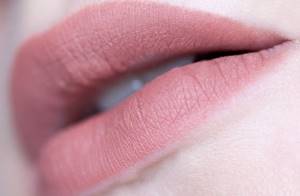
According to the etiology of development, the following forms of ulcers on the inner side of the lip are distinguished:
- Candida. Fungi of the genus Candida are present in the oral cavity of every person. The weakening of the body’s protective properties provokes the activation of such microflora. The resulting white element on the mucous surface of the lips is represented by a film. Cleansing is accompanied by the presence of erosions.
- Aphthous. It is expressed as an ulcer covered with a gray-white coating, the removal of which is accompanied by exposure of an erosive bleeding surface. The element has red and raised edges, causing pain and itching. There is likely to be an increase in temperature and sensitivity of the oral mucous tissues, swelling and bleeding of the gums.
- Herpes. Triggered by the herpes virus. The formation of particles in the form of bubbles with colorless contents, subject to rapid opening, fibrous plaque, is preceded by some signs. Patients suffer from itching and burning sensations.
- Traumatic. Caused by mechanical, thermal or chemical influence. Characteristic symptoms of inflammation occur in the area of injury: swelling, redness, pain, and plaque formation.
- Bacterial. The main factor of damage is microflora. Most often, microorganisms that enter through damaged mucous membranes are represented by streptococci and staphylococci. Signs of the process include swelling, redness, pain, and bad breath. The long course of the disease is aggravated by asthenic phenomena and temperature.
- Allergic. Prerequisites for its occurrence are contact with certain foods, medications and other substances (dust, fur, animals). Expressed by swelling, redness, pain of the mucous membrane. The inside of the lip becomes smooth, and the resulting bubbles quickly open. There is a tendency for erosions to merge.
For these reasons, the treatment of a lip ulcer begins to worry the patient immediately after the first signs of the disease appear.
Treatment methods
Traditional and folk methods of treating the disease are provided. Of primary importance is relieving inflammation and eliminating pain. To accurately diagnose the disease, it is better to seek medical help. The specialist will adequately assess the situation and competently prescribe treatment.
You should not put off visiting a doctor, as the lack of proper therapy can worsen your health and provoke a secondary infection. Then the treatment will be lengthy, and diagnosing the etiology will become difficult.
For the treatment of ulcers on the inside of the lip, medications are prescribed:
- painkillers: Anestol, Lidocaine, Lidoxor, Kamistad, Novocaine,
- antifungal: nystatin ointment, Clotrimazole cream, Levorin,
- disinfectants for rinsing: chlorhexidine, Furacilin, hydrogen peroxide, Lugol's solution,
- antiviral: acyclovir ointment, Zovirax.
After the inflammation is removed, it is necessary to restore the damaged tissue. Aaecol, Solcoseryl, vitamin E oil solution, Cigerol, Emparkol are often used.
When an ulcer forms not only on the internal tissues of the lip, but also on the external ones, oxolinic, interferon or retinoic ointments are used. Treatment is carried out under medical supervision.
Correctly chosen tactics can eliminate unpleasant symptoms within a week. At this time, it is better to avoid eating hot, spicy foods, as well as alcohol and cigarettes.
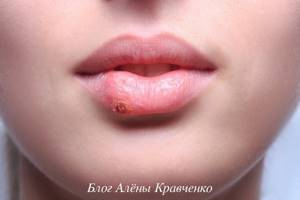
Folk remedies for treating ulcers include recipes:
- soda solution. Prepared by dissolving 1 tsp. soda in a glass of warm boiled water. Use the resulting mixture for rinsing or lubricating painful areas,
- Oak bark. A decoction of the plant has an anti-inflammatory, healing effect,
- Kalanchoe juice. Cut a leaf of the plant and divide it lengthwise. Apply the cut to the affected area,
- chamomile or calendula. Flower decoctions relieve inflammation, pain and disinfect.
Before using folk remedies, you should consult with a specialist about combining them with drug therapy. Do you feel nervous before visiting the dentist?YesNo
The best solution to prevent ulcers on the inside of the lip is its prevention, which consists of the following:
- The food consumed should be at the optimal temperature,
- brushing teeth twice a day, using dental floss,
- stop using antimicrobial balms, mouth rinses,
- avoid close contact with people infected or who have recently suffered from a viral pathology,
- rinse your mouth after every meal,
- Maintain physical activity of the body, eat more fruits and vegetables.
Ulcers that appear on the lips are a common occurrence. With timely treatment, they do not pose a threat to human health. It is still not recommended to resort to self-medication, as this threatens the development of additional ailments.
Ulcers always appear unexpectedly and are characterized by rapid growth. To prevent the expansion of the affected area and the appearance of new formations, treatment of the injury should be started immediately.
Causes of the phenomenon
The appearance of wounds in the mouth is associated with the reaction of the protective system to the influence of external and internal factors. In this case, an ulcer on the lip occurs due to the body’s inability to detect molecules that have entered the internal environment. There are several groups of sources that provoke the development of sores:
- fungal infections;
- viruses;
- bacteria;
- allergies;
- chronic pathologies of the endocrine system and gastrointestinal tract.
Despite the variety of sources of ulcers, they are not capable of harming an organism with a strong immune system.
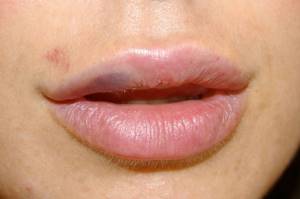
To successfully eliminate wounds, the reasons for their development must be determined. The prerequisites for the occurrence of ulcers are:
- exfoliation of the surface of the lips with coarse particles, exposure to aggressive components, poor cosmetics;
- traumatic tissue damage – constant lip biting;
- stress.
Smoking and other harmful habits often cause ulcers. In addition to their inhibitory effect on the defense system, they provoke an imbalance in the water balance in the body, which causes lips to crack and sores to appear. In children, the development of stomatitis is often associated with the effects of colds, which negatively affect weak, just developing immunity.
Possible complications
Possible complications from a bruise are:
- penetration of infection through the wound surface with subsequent formation of purulent masses. This condition threatens blood poisoning;
- deep damage, which can further cause lip deformation.
A lip bruise usually does not have serious consequences. However, it is important to properly care for the injury to prevent infection. Also, after damage, you should undergo examinations to exclude the possibility of damage to other structures.
In what cases is the lip sutured? The doctor decides this after examining the wound.
If the wound on the lip is deep, with diverging edges, you should definitely contact the nearest trauma hospital. You should be especially concerned if the bleeding is severe.
When examining the wound, the doctor will determine whether surgery is required and how to stitch the lip. Doctors usually make this decision if the length of the cut is more than 2 cm, and the edges of the wound are more than 7 mm apart from each other.
Before contacting a doctor, it is important to provide first aid correctly.
- Wash the wound by wiping it with a cotton swab dipped in warm water. It is better to open your mouth so that rinsing is more effective.
- Wipe your lip with a weak solution of hydrogen peroxide or potassium permanganate. Peroxide also helps stop bleeding.
You can treat the wound with chlorhexidine solution. You cannot use brilliant green or iodine, as they can cause burns. After stopping the bleeding, it is better to apply ice to the lip - it helps eliminate pain and swelling.
Processing agents
A sore on the lip is a painful injury to the delicate skin on the outside or inside.
May be caused by mechanical damage or infection. If the injury does not heal for a long time, you should consult a doctor. Careless actions of a housewife who decided to try cooked food from a knife or a man who made a mistake while shaving and made a cut are the causes of the problem. Lacerated and cut wounds pose a danger to human health. Ragged injuries can be caused by a bruise, blow or bite from an animal.
Timely treatment of an open wound will help stop bleeding and prevent the penetration of pathogenic microbes. Lack of quality care will lead to complications and a long-term non-healing surface. It is recommended to visit the hospital; sometimes severe bruises and deep cuts require surgical intervention - suturing.
Lacerations in adults who were treated following all the rules disappear within one month. Healing depends on the individual characteristics of the body and the speed of metabolic processes.
If the damaged surface does not heal within two weeks, you should visit a doctor. There is a risk of developing purulent complications and tissue death. In some cases, treatment does not help. The damage does not have smooth edges and constantly bleeds - symptoms of malignant transformation of the wound. Cancer develops under the influence of sunlight, abuse of tanning beds, and constant lip biting.
Many people have encountered the phenomenon of a sore on the lip. This trouble can appear due to various reasons, regardless of age category. You should not ignore a wound on the lip, which takes a very long time to heal, as this is fraught with suppuration and further sepsis. If a wound on the lip does not heal, and a person does nothing to treat it, this can lead to the appearance of an unsightly scar on the skin.
The causes of sores on the lips can be different. The most common factor is infection with the herpes virus. The virus can lie dormant in the human body for a long time, becoming more active under the influence of certain conditions. Symptoms of the development of the disease are ulcers or wounds on the lips; they can appear on both the outer and inner sides of the lip. If proper and timely treatment is not provided, the virus will spread further, affecting surrounding tissues.
Other causes of wounds:
- abrasions;
- development of stomatitis;
- chronic dry skin of the lips;
- mechanical damage, resulting in a laceration of the lip, cut, bruise;
- pet or insect bites;
- acute lack of B vitamins;
- having a bad habit of licking your lips, which often results in painful cracks;
- jams;
- iron deficiency, chronic anemia;
- dysfunctions in the metabolic process;
- the wound may not heal for a long time or may fester after the piercing;
- thermal or chemical burns;
- allergic reactions to certain irritants (hygiene products, food products, cosmetics).
Damage to the upper or lower lip from the inside can occur due to trauma to the mucous membrane from a sharp tooth or a poorly placed filling. The most dangerous are lacerations. Such injuries usually do not heal for a long time, they are difficult to stitch, and there is a high risk of complications (for example, accumulation of purulent discharge).
This problem needs to be described separately, since a lacerated or cut wound is dangerous. The reasons are trivial - for example, the housewife, while preparing dinner, tasted food from a knife, cut herself, or the man was shaving and made a careless move, resulting in a cut. Such damage is dangerous due to infection.
Regardless of how the lip is injured, bleeding usually occurs. It can be abundant, since the lip is penetrated by a large number of capillaries and vessels. What to do first? First you need to stop the bleeding. For this purpose, hydrogen peroxide is used; this product also has a bactericidal effect, so that germs will not get into the wound. Using a folded bandage or cotton swab soaked in peroxide, carefully treat the damaged area.
To slightly reduce the severity of pain and prevent the development of severe swelling, it is recommended to apply ice wrapped in a clean towel to the damaged area. Such manipulations also help stop bleeding, since the blood vessels constrict under the influence of cold. If the pain is very severe, you can take a painkiller tablet once.
The healing process of such damage can take a very long time, especially if proper treatment is not available. A non-healing wound can cause a large number of consequences and complications. It is important to go to the hospital in time; the doctor must examine the wound, clean it if necessary, treat it with antiseptic solutions, and, if necessary, stitch it up.
Often after an injury, to prevent a deep wound from festering, doctors prescribe antibacterial drugs. In case of wounds, a sterile bandage is applied to the area of the sutures, onto which a wound-healing agent is first applied. How quickly does damage heal? The process of tissue regeneration depends on the individual characteristics of the body and the speed of metabolic processes.
Additional warning signs are enlarged lymph nodes in the neck. In such a situation, you must immediately visit a doctor and undergo appropriate examinations. Such symptoms may indicate the development of oncological processes.
Chief author and editor-in-chief: Makarskaya S.E., 29 years of experience.
Separately, it is worth mentioning lacerations, since they are very dangerous. It happens that a woman, while preparing dinner, tried something with a knife and cut her lip, or a man made a careless movement with his hand and cut himself while shaving, a cut wound appears, which can become infected. You can fall and hit your mouth, resulting in a bruised wound that can be lacerated. The edges of such damage diverge, it bleeds, the lip swells and hurts. With such damage, problems with eating arise.
With any injury to the lips, blood begins to flow, since the lips are penetrated by many capillaries and small vessels. First aid begins with stopping bleeding. Hydrogen peroxide has a good hemostatic effect; at the same time, it disinfects the injury site, preventing germs from entering the wound. It is necessary to moisten the bandage in peroxide and press it to the lip.
It is better not to use cotton wool to treat wounds, as its fibers may remain in the wound surface, which will cause complications. To relieve pain, you can apply ice wrapped in a cloth to your lip; this also helps stop the bleeding and relieve swelling. If the pain is very severe, you can take a painkiller tablet.
Such a wound may not heal for a long time if it is not treated, and a non-healing wound can cause a number of complications and consequences. When a victim goes to the hospital, the attending doctor examines the wound, cleans it if there are foreign bodies in the wound surface, and then treats it with antiseptic agents. If necessary, the doctor applies one or more stitches and performs postoperative treatment.
Then the doctor will tell you how to treat the wound so that it heals faster. To do this, you can use healing ointments or gels that promote tissue regeneration and relieve inflammation. Sometimes antibacterial drugs may be prescribed to prevent the wound from festering. A sterile bandage using healing agents can be applied to the postoperative suture.
If white sores appear on the lip outside or inside, the painful sores must be treated immediately. More often, this symptom is associated with mechanical injury to the oral mucosa or increased activity of the herpes virus. In any case, the wound on the lip should not be left without proper attention, so a visit to the local police officer should follow immediately.
We suggest you familiarize yourself with Ulcers on the tongue: on the side, under the tongue, on the tip - Causes of occurrence, how to treat sores
From the outside
- The ulcer will heal faster if you prepare decoctions of lemon balm, St. John's wort, and chamomile (in a 1:1 ratio with water). Leave for 24 hours and add 1 tsp. boric alcohol. Lubricate the affected areas.
- Mix carrot juice with warm water in a 1:1 ratio.
- Rinse your mouth with a solution of hydrogen peroxide and water (1:1).
- Aloe juice will remove open wounds.
- Lotions made from chamomile and boric acid. Add 5 grams of chamomile infusion to a glass. boric acid and mix thoroughly, moisten a cloth in the solution and apply to the affected areas 3-4 times a day.
- It is recommended to treat erosion with aloe juice
- St. John's wort infusion is also effective in treatment due to its antiseptic, healing and regenerating properties.
- Propolis will help get rid of pain, speed up the healing of damage, disinfect and disinfect. You should wipe the sores with 3% hydrogen peroxide, then apply an alcohol-containing propolis tincture until a protective film appears. Carry out the procedure for 4-6 days.
What to put on a stitched lip
To ensure that the wound heals well, the lip should be treated with special ointments. They can be purchased at a pharmacy or made at home. The stitched lip should be lubricated:
- a mixture of honey and propolis, taken in equal quantities;
- zinc ointment;
- sea buckthorn oil;
- propolis ointment.
One of these products is used to treat the lip several times a day. It is important to try not to lick the ointment. To prevent the inflammatory process and the formation of pus, you need to rinse your mouth with chamomile decoction - this is especially necessary if the wound is on the inside of the lip.
How long does it take for a stitched lip to heal? This process is purely individual and depends on the patient’s age, blood supply to the damaged area, the presence of chronic diseases, immune status, etc. Usually the wound heals within 8-9 days. Then the sutures are removed if they were applied with non-absorbable threads.
The doctor decides after an examination whether to sew up a cut lip or not. The main thing is to provide first aid correctly and not delay going to the hospital in order to avoid infection of the wound and the spread of infection.
To get injured, you don't have to get into fights or engage in extreme sports, just an awkward turn or an accidental fall. Simple bruises and abrasions are quite common; a person becomes familiar with them in childhood, but a cut lip can frighten not only the injured person, but also everyone around him. What to do and how to quickly provide first aid? How can such damage be dangerous?
My child has a broken lip, what should I use to treat it?
To treat a child's broken lip, disinfectants are used, but not iodine, brilliant green, other alcohol solutions and irritating drugs.
What to put on a child's broken lip
First you need to rinse the child’s lip with clean water, and then rinse with peroxide, a solution of potassium permanganate or other similar means. It is imperative to treat the wound with antiseptic agents. Anti-inflammatory medications can also be applied to a split lip. In such cases, you can anoint the wound with zinc or propolis ointment, or products with calendula. For faster healing, a broken lip can be lubricated with Bepanten or Solcoseryl. At the same time, you need to make sure that the baby does not lick or eat the applied product.
The child broke his lip on the outside. Will there be a scar?
Whether a scar remains after a child breaks his lip is determined by the extent and severity of the injury. If the wound is too large and severe, or if there is heavy bleeding, medical intervention and stitches may be required. In this case, small marks may remain on the child's lip. Pronounced scars often remain when the damage is treated incorrectly and when such products as iodine, brilliant green, etc. are used.
Childhood is the most active period in a person’s life. A child receives injuries every day, this is how he adapts to the world, learns what pain is and what to do to avoid traumatic behavior. When falling, it often happens that the baby hits his face down, not having time to hold his own body with his hands, then his face suffers: forehead, nose and lips. These places are very sensitive to pain, so the child begins to have a violent reaction - he cries, a lump on his forehead grows, his nose is broken and blood flows from it, his lip is also injured and swollen, and the parents do not know what actions to take first. If a child breaks his lip, what to do?
Causes of injury
In everyday life, lip dissection occurs most often due to negligence or accident. You can trip, fall and hit your face, or find yourself in the path of a stone thrown by someone. Traumatologists note that some of the injuries people receive are the result of curious and incredible coincidences. There was a recorded case where a man went to the emergency room after being attacked by a chicken.
The consequences of a fight, beating or robbery do not belong to domestic injuries, but belong to the sphere of offenses. A split lip may be accompanied by associated injuries that complicate the healing process. Any complicating factor is a strong argument in favor of refusing self-medication and contacting a traumatology department.
First aid and proper damage assessment
A large number of small blood vessels, close proximity to the mucous membrane, a complex muscular structure that provides rich facial expressions - all these factors directly influence the immediate aggravating symptoms that accompany even a slight cut of the lip.
Severe and rapidly worsening swelling and heavy bleeding make it difficult to quickly assess the severity of the injury. Therefore, it is recommended to follow a simple algorithm: if possible, stop the bleeding and wash the wound, apply cold.
Important: an ice compress can be applied for no more than fifteen minutes, after which you must take a break of equal duration.
The main parameters of dissection are the length of the relative red border of the lips and the width of the resulting wound. If the tear extends beyond the red border of the lips, then serious damage to the muscle fibers can be suspected, and a width of more than 7 mm is a clear indication for surgical help.
How to treat a split lip
If the wound needs to be sutured, then it is better not to argue with the doctor on this issue. The fact is that due to the specific location of the injury, healing can be seriously complicated, and it is better to put stitches. As a rule, it is not possible to bring the edges of the wound closer together with a plaster on the lip.
It is better to wash a broken lip with chlorhexidine. Hydrogen peroxide can be used if there is contamination in the wound, in which case the internal tissue may turn white. This is not pus; you should not try to remove the white inclusions formed due to the initial treatment. Zelenka, iodine, and any alcohol solutions are strictly contraindicated; do not aggravate the damage with a burn.
At first, you can cover fresh stitches with a sterile gauze pad and secure them with a band-aid, but in most cases this is not required.
Healing process
In order for treatment to be quick and effective, the specific location of the injury must be taken into account. A healing lip cut is constantly exposed to various influences, because in most cases a person cannot ensure absolute immobility of fresh sutures. The wound is disturbed during conversation or eating, so at least for the first couple of days it is recommended that speech rest and a diet that does not require active chewing movements. This is especially true if the dissection is accompanied by injury to the gums and teeth.
Child's split lip
If an adult is injured, it is to some extent easier to bear. But at such a moment the child becomes more frightened and may scream, involuntarily aggravating the problem - when screaming, the mouth opens wide, the lips become tense, and the cut receives additional negative effects. Therefore, first of all, the baby needs to be reassured, consoled, and persuaded to be patient.
What to do if a child has a cut lip and is it worth self-medicating? Even if you think it is a minor injury, it is better to consult a doctor. Parents are responsible for the child, and it is better to be safe. It is important to remain calm and confident, because panicking adults only worsen the condition of an already frightened baby.
Otherwise, the treatment process follows the same rules as for adults, except that you should pay closer attention to the cleanliness of the wound, especially in small children.
How to treat and treat a broken lip
You need to care for and treat the wound until it is completely healed. For this purpose, medications are used in the form of ointments, creams, gels and antiseptic solutions. Before applying the medicinal ointment, the wound must be treated with an antiseptic. To do this, you can use the following disinfectant solutions:
- Furacilina.
For 3 to 5 days after injury, wash the wound with furatsilin solution; - Miramistin and Chlorhexidine.
These solutions have high antiseptic characteristics. They can also pre-treat your hands so as not to introduce infection into the child’s wound.
Almost always, the next day after a bruised lip, the child develops swelling and hematoma in the damaged area. To eliminate swelling and cure a broken lip, you need to use safe drugs based on natural ingredients:
- Zinc ointment
is a mixture of substance oxide and petroleum jelly. This drug has a pronounced protective and softening effect. It helps relieve inflammation and accelerates healing; - Bepanten
based on dexpanthenol is used for wounds that contain a high risk of infection. The cream accelerates regeneration; - The healer
is a balm based on tea tree oil, sea buckthorn, olive oil and other natural ingredients. It is an affordable and highly effective wound healing agent; - Boro Plus
is a medicinal ointment that has a pronounced antiseptic effect. It has a wide spectrum of action and is used for wound healing. It contains only natural antibacterial ingredients;
- La-Cri cream
has a pronounced anti-inflammatory effect and heals wounds. This remedy helps eliminate itching and irritation; - Solcoseryl
ointment is indicated from the moment fresh granulations appear until the wound dries. This remedy helps to quickly restore the outer layer of skin and mucous membranes; - Badyaga gel
heals wounds and treats inflammation. It accelerates the resorption of hematomas and helps remove scars.
To speed up regeneration, apply ointments several times a day and make sure that the child does not tear off the crust that appears during the healing process.
Possible misconceptions and complications
Any damage to the face seriously spoils the appearance and attracts unnecessary attention, so all victims are concerned about how long it takes for a cut lip to heal. If there is no inflammation, then after a few days you will notice a significant improvement. The exact timing depends on the severity of the damage.
Getting an infection into the wound aggravates the problem. The inflammatory process begins, the rupture can “turn out”. Redness of surrounding tissues and swelling, accumulation of purulent exudate - if all of the above symptoms are observed, the doctor will prescribe appropriate medications. However, fibrin plaque is taken as a sign of inflammation, which should not be peeled off or washed.
Caring for the wound is actually very simple. You need to try not to disturb the fresh seam, and Levomekol ointment, which has weak antibacterial properties, is perfect for softening. It is not worth drying with alcohol solutions; they can provoke the formation of a rough scab, which, contrary to common misconceptions, does not contribute to a quick recovery.
It often happens that a child who has just begun to walk independently tries to get to the highest and most forbidden places in the house. Naturally, the consequences can be bruises, abrasions, bumps and broken lips. Broken, bloody lips are a very unpleasant situation. They take quite a long time to heal and tighten the skin. Children cannot help but touch them with their hands, which means that the wound may become infected. What needs to be done to get rid of this trouble as quickly as possible? How to heal a lip that has been split?
What is contraindicated to do in case of injury

To avoid leaving heavy scars, it is important to know the correct behavior during treatment. Rapid healing will occur if:
- Carry out comprehensive measures to treat the wound to relieve swelling.
- Care must be taken not to accidentally tear the crusts that have formed.
- You should not use heat compresses if you have a broken lip due to swelling. So the healing wound will bother you for a long time, leaving scars.
- It is not recommended to eat food after you have a broken lip.
- During recovery, you should not consume too cold or hot foods, alcoholic beverages, and minimize smoking.
- Do not touch your lips with your hands, do not bite them, do not tear off the scabs, this will take longer for the wound to heal, and scars may remain.
- Avoid kissing and avoid direct sunlight.
How long does it take for healing to take place? With proper treatment and compliance with all necessary measures, the wound will heal in a short time.
Chief author and editor-in-chief: Makarskaya S.E., 29 years of experience.
First aid
Always clean the lip wound with hydrogen peroxide first. After this you need to apply something cold. An ice pack from the freezer will do. This will get rid of swelling and help the wound heal quickly.
When treating a broken lip, first aid will be provided by simple folk recipes and some medications:
Honey. Propolis ointment. Lanolin. Chapstick or lip balm. Miramistin. Sea buckthorn oil. Zinc ointment. Adhesive pastes, etc.
Folk remedies and medications for the treatment of broken lips
The wounded part of the face can be lubricated with ordinary honey, which will save the wound from harmful microbes and allow it to heal faster. If you have propolis ointment in your home medicine cabinet, you can use it. This ointment should be mixed with the same honey and applied to the damaged lip throughout the day. The ideal option is to apply it on your lips at night. But this must be done so that the child does not have time to lick the sweet treat from his lips. Overnight, the ointment will be completely absorbed, and the effect will be almost instantaneous.
Before going outside, a broken lip must be lubricated with hygienic lipstick, or lanolin.
In addition to the methods described above, Miramistin diluted with water can also be applied to the damaged lip. You can also rinse your mouth with this solution if your lip is damaged not only outside, but also inside the oral cavity.
The use of sea buckthorn oil can give good results. But this only applies to cases where the wound is not very deep. Zinc ointment is a remedy that has been proven for decades. Among modern medicines, adhesive pastes are recommended, for example, asepta, solcoseryl.
Treatment of an injured lip
A lip wound causes a lot of trouble to the patient. It can hurt and bleed for a long time.
In order to achieve recovery of a damaged lip as soon as possible, it is advisable to consider some tips:
- First you need to clean the wound well and treat it with antiseptics. If there is swelling, ice should be applied to the bruised site.
- Stop the bleeding.
- If the injury is serious, you will have to go to the trauma center.
- If the labial wound is mild, special wound-healing ointments can be used for treatment.
- A good way would be to use traditional methods of treatment. This is, for example, olive or sea buckthorn oil.
- The use of zinc-based ointment has a fairly beneficial effect on the healing process of lip wounds.
- In order to protect damage from the rays of the sun, wind and other weather conditions, before going outside, you need to anoint your lips with hygienic lipstick.
Treatment of a lacerated wound of the lip, if these rules are carefully followed, will not take much time and cause great inconvenience to the patient. There are many reasons for the occurrence of labial sores, and each of them has its own treatment method. First, you need to go to the doctor to discuss the reason for the laceration of the lip. It is necessary to wash it with any disinfectant solutions, such as hydrogen peroxide or potassium permanganate, because lips can become infected very quickly.
The victim needs to stop the bleeding. This is not a very difficult task because there are no large blood vessels on the lips. Lacerations on the lips tend to heal quite easily and quickly. But, if the damage is large, you need to urgently visit the emergency room. There may be a need for stitches. The intervention of a plastic surgeon is required only in rare cases. If there are persistent cracks on the lips, you need to take tableted vitamins or eat foods rich in vitamins.
It is necessary to constantly lubricate your lips with ointments and balms that will soften them. Women can use a moisturizing chapstick.
What can't you do?
You should never smear a damaged lip with brilliant green and iodine. The child will suffer even more, because it is impossible to achieve the desired effect, but it is quite possible to burn the lip. After such a burn, new wounds may appear on the lip.
Remember that if a child breaks his lip, you can only provide first aid. Carefully examine the wound and assess its depth. If the wound on the lip is deep enough, then after first aid the injured child must be shown to a traumatologist. It is likely that you will need to get stitches or use staples.
Treatment of various wounds on the lips
Lip sores are very common and can appear on the upper or lower lip of a child, man or woman at any age. Such damage to the mouth area occurs for a variety of reasons, which the doctor must pay attention to when making a diagnosis and prescribing treatment.
You should not let the healing of a wound on your lips take its course, because it can fester and the pus will go into the blood. If a wound on the lip is left untreated, it will take longer to heal and an unsightly scar may form.
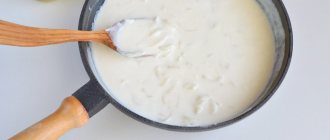


![[Photo review] “A Sassy Nation” bodysuit from Black Milk Clothing](https://superlady555.ru/wp-content/uploads/fotoobzor-bodi-a-sassy-nation-ot-black-milk-clothing-330x140.jpg)

